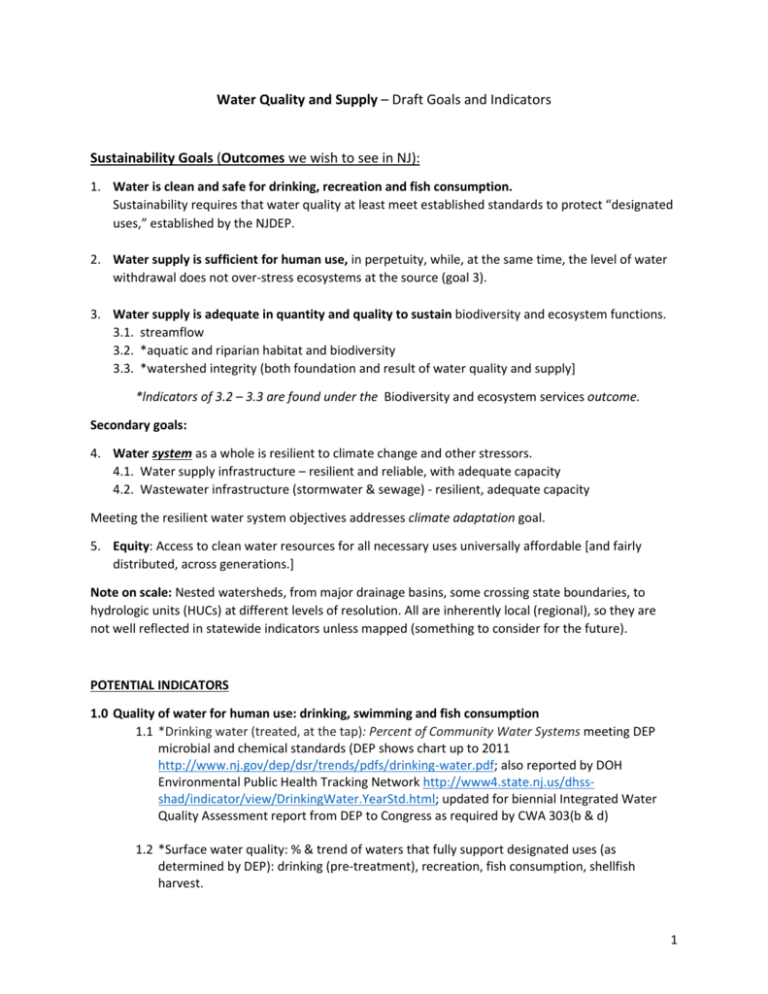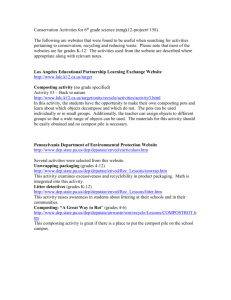Water Quality and Supply – Draft Goals and Indicators Sustainability
advertisement

Water Quality and Supply – Draft Goals and Indicators Sustainability Goals (Outcomes we wish to see in NJ): 1. Water is clean and safe for drinking, recreation and fish consumption. Sustainability requires that water quality at least meet established standards to protect “designated uses,” established by the NJDEP. 2. Water supply is sufficient for human use, in perpetuity, while, at the same time, the level of water withdrawal does not over-stress ecosystems at the source (goal 3). 3. Water supply is adequate in quantity and quality to sustain biodiversity and ecosystem functions. 3.1. streamflow 3.2. *aquatic and riparian habitat and biodiversity 3.3. *watershed integrity (both foundation and result of water quality and supply] *lndicators of 3.2 – 3.3 are found under the Biodiversity and ecosystem services outcome. Secondary goals: 4. Water system as a whole is resilient to climate change and other stressors. 4.1. Water supply infrastructure – resilient and reliable, with adequate capacity 4.2. Wastewater infrastructure (stormwater & sewage) - resilient, adequate capacity Meeting the resilient water system objectives addresses climate adaptation goal. 5. Equity: Access to clean water resources for all necessary uses universally affordable [and fairly distributed, across generations.] Note on scale: Nested watersheds, from major drainage basins, some crossing state boundaries, to hydrologic units (HUCs) at different levels of resolution. All are inherently local (regional), so they are not well reflected in statewide indicators unless mapped (something to consider for the future). POTENTIAL INDICATORS 1.0 Quality of water for human use: drinking, swimming and fish consumption 1.1 *Drinking water (treated, at the tap): Percent of Community Water Systems meeting DEP microbial and chemical standards (DEP shows chart up to 2011 http://www.nj.gov/dep/dsr/trends/pdfs/drinking-water.pdf; also reported by DOH Environmental Public Health Tracking Network http://www4.state.nj.us/dhssshad/indicator/view/DrinkingWater.YearStd.html; updated for biennial Integrated Water Quality Assessment report from DEP to Congress as required by CWA 303(b & d) 1.2 *Surface water quality: % & trend of waters that fully support designated uses (as determined by DEP): drinking (pre-treatment), recreation, fish consumption, shellfish harvest. 1 2.0 Water supply for human uses Water supply for human needs must be balanced against the needs of other species and the capacity of ecosystems to continue to supply sustainable services. Water withdrawals reflect the efficiency of water use, human preferences, and thus cultural values (e.g., for green lawns vs. conservation). If they do not stress upstream ecosystems, then the system is sustainable. *2.1 (& 3.1) percent of watersheds where water use from unconfined aquifers and stream baseflow sources were no greater than 25%1of the Low Flow Margin for that watershed in the year of peak demand over a 5-10 year period. The baseline value is for the 2000-2009 period. Subsequent values will be based on a rolling five-year window. (Source: NJGWS computer workbook for watersheds on a HUC 11 basis, DGW 14-1) Although this physical measure is intended to indicate that human uses are satisfied putting excessive strain on natural systems, it should be corroborated by biological data (covered under 3.3). 3.0 Ecosystem vitality: functioning ecosystem services Sustaining healthy ecosystem functions imposes ecological constraints on human use (goal 2), limiting water withdrawals and pollution for the sake of both natural and human communities. Note that biodiversity is an effective indicator of these elements as well as an inherent value and goal in its own right. Thus, two of the ‘water’ indicators (3.2-3.3) are listed under the Biodiversity & Ecosystem Services outcomes. Strongly influenced by land use decisions (reflected under Built environment outcomes), these indicators register the impact of such factors as habitat loss, habitat fragmentation, and impervious land cover (development). 3.1 3.2 3.3 Streamflow (listed under 3.1) *Aquatic and riparian habitat and biodiversity (listed under Biodiversity outcome) Watershed integrity (listed under Biodiversity [or Built Environment] outcome) 4.0 Water system resilience (supports climate resilience goal) 4.1 Estimated cost of upgrading existing infrastructure to regulatory compliance standard … plus additional increment to prepare for impacts of climate change 5.0 Equity The key to equity with respect to water is equitable access to water resources. For New Jersey residents to have access to clean water it must be affordable relative to their household income and other expenses. Average or median values do not show this. 1 25% level may (or may not) be cited in the yet-to-be released NJ State Water Supply Plan. (Note that a higher standard is as specified by state regulations or adopted plans in some regions (e.g., 5% in portions of Highlands)). 2 5.1 Affordability: Cost of water and sewer as a % of household income, per quintile (or for bottom two quintiles) --------------------------------------------------------------------- Additional or alternative indicators (for possible future use or deeper analysis): 1.0 Water quality: Ground Water Quality: # violations per watershed/population, or trend in conditions for contaminants, assessed by Ambient Ground Water Quality Monitoring Network http://www.nj.gov/dep/dsr/trends/pdfs/surfacewater-physical.pdf 1.2 % of Private Wells that meet all primary MCLs (maximum contaminant levels, same sources) Trend &/or % of DEP sampling sites (better indicated as a map) with impaired levels of dissolved oxygen. These sites include estuaries and near shore ocean waters. 2.0 Water Supply o % of state’s land area meeting this standard at watershed level o % of people consuming water from a watershed that is stressed by this definition. (Source NJGWS DGS-14 tool) The stream flow indicator does not cover all elements of the water supply. A complete indicator set would also include confined aquifers and reservoirs; however, these are already tracked and highly regulated by DEP and difficult for municipalities to influence directly 4.1 Water Use – decreased demand, increased efficiency and conservation. % of PWS where ratio of summer household water use/winter water use is less than or equal to [target] (or reduction of use at target rate). This indicator is recommended since the critical domestic water stress in NJ is summer use, specifically watering lawns; in other respects household conservation has improved, and is regulated in new homes, for personal use. Additional or alternative indicators: Potable withdrawals/capita in watersheds (@HUC 14?) with deficit water availability (defined by DEP). (Target: 75 gpcd?) o rate of change of gpcd (should be decreasing, could set target for rate of reduction, e.g. 5 gpcd over 5 year period, until reach some target (45 gpcd?). Agricultural withdrawals/capita in watersheds (@HUC 14?) with deficit water availability (defined by DEP). (No standard available, so could set target rate of decrease) Water use per irrigated acre 4.2 & 4.3 Water infrastructure – reliable and resilient infrastructure with adequate capacity, at lowest lifecycle cost. [Note equity implications below] % of water treatment [+ other critical water infrastructure] located outside of flood hazard areas [or elevated or hardened; & w/ extreme weather backups] (NJ Floodmapper) 3 Pipeline System annual breaks per pipeline mile, trend and absolute; or o % water loss Sewage system annual breaks per pipeline mile ( could combine w/ above) (source: utilities) Wastewater System Net Capacity: available capacity, calculated as design or planning flows relative to peak flows. A good integrative indicator, since capacity may be increased through reduced stormwater and ground water flows into the pipeline system, reduced consumer sewage creation (e.g., reduced indoor water use), diversion of stormwater from combined sewer systems (e.g., system separation, green technology, stormwater reuse), or development of additional treatment plant or flow equalization capacity. (Source: NJDEP defines available capacity and NJAC 7:15 (water quality management planning rules) requires that it be identified in wastewater management plans. Legislature has twice put off the due date for these plans, but they are now coming due so this information should be available). Water supply utilities with water losses that exceed acceptable levels either established by the NJDEP regulations* or AWWA Manual M36C Water Audits and Loss Control Programs, Third Edition. *(25% “unaccounted for water,” basically non-revenue water – goes out of the treatment plant but then doesn’t get to a billable customer.) CSO volumes and discharge days (soon to be regulated; only 21 munis will manage own) % beneficial reuse of stormwater green infrastructure incentive: % of urban watershed stormwater managed by green infrastructure and infiltration systems? [no data; links to land use] 5.0 Equity: Spatial distribution Location of adequate, resilient water infrastructure (4.2 – 4.4) relative to % residents who are low-income, % people of color Cost of water and sewer as a % of household income, per quintile on a municipal basis 4











